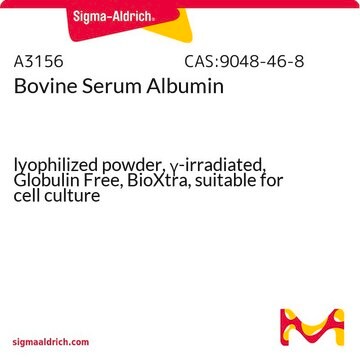A3311
Bovine Serum Albumin
powder, BioXtra
Synonym(s):
Albumin bovine serum, BSA, Bovine albumin
About This Item
Recommended Products
biological source
bovine
Quality Level
product line
BioXtra
Assay
≥98% (agarose gel electrophoresis)
form
powder
mol wt
~66 kDa
packaging
poly bottle of
origin
USA origin
technique(s)
cell culture | embryo: suitable
loss
≤5%
pH
6.5-7.5
solubility
water: soluble (40 mg/ml)
shipped in
ambient
storage temp.
2-8°C
Looking for similar products? Visit Product Comparison Guide
Application
Biochem/physiol Actions
Preparation Note
Storage Class Code
11 - Combustible Solids
WGK
WGK 3
Flash Point(F)
Not applicable
Flash Point(C)
Not applicable
Personal Protective Equipment
Certificates of Analysis (COA)
Search for Certificates of Analysis (COA) by entering the products Lot/Batch Number. Lot and Batch Numbers can be found on a product’s label following the words ‘Lot’ or ‘Batch’.
Already Own This Product?
Find documentation for the products that you have recently purchased in the Document Library.
Customers Also Viewed
Articles
Explore serum albumin's role in serum-free cell culture systems for biomanufacturing.
Explore serum albumin's role in serum-free cell culture systems for biomanufacturing.
Explore serum albumin's role in serum-free cell culture systems for biomanufacturing.
Explore serum albumin's role in serum-free cell culture systems for biomanufacturing.
Related Content
Learn about bovine serum albumin (BSA) structure, molecular weight, function, solubility, how BSA is made, purification methods, applications and purchasing.
Learn about bovine serum albumin (BSA) structure, molecular weight, function, solubility, how BSA is made, purification methods, applications and purchasing.
Learn about bovine serum albumin (BSA) structure, molecular weight, function, solubility, how BSA is made, purification methods, applications and purchasing.
Learn about bovine serum albumin (BSA) structure, molecular weight, function, solubility, how BSA is made, purification methods, applications and purchasing.
Our team of scientists has experience in all areas of research including Life Science, Material Science, Chemical Synthesis, Chromatography, Analytical and many others.
Contact Technical Service


